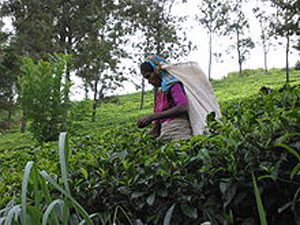Lankan plantations hit by fertiliser shortage, could lead to tea revenue loss
View(s):Sri Lankan plantations have been hit by an acute shortage of fertiliser and the Planter’s Association of Ceylon (PA) says this would have a detrimental effect on the industry.
In a statement, the PA appealed to all stakeholders to come together to resolve the fertiliser crisis.
Fertiliser subsidies are provided by the Government for paddy and plantation crops (tea, rubber, and coconut). Importation and distribution of fertiliser is carried out by different institutions. The fertiliser scheme enables the importers to sell the fertiliser at a subsidized rate and seek a rebate from the Government. However, the rebate process itself is cumbersome and takes a long time to be realised discouraging the importers. Adding to the dilemma, the ballooning subsidy bill has caused growing concern for the Government resulting in a cap on fertiliser importation, the PA statement said.
Crisis affecting tea
“The shortage and the ill-timing of fertiliser application will result in loss of crop, reduction of green leaf quality, leading to a detrimental effect on tea quality and the inability for the estates to offer a sufficient number of days work to the workers due to lack of crop,” says Roshan Rajadurai, Chairman, Planters’ Association of Ceylon, explaining the extent of the crisis in the statement.
“The Regional Plantation Companies (RPCs) produce around 20-23 million kgs of tea in the first quarter of the year. Due to the lack of fertiliser, we may lose about 6-7 million kg of made tea incurring a loss of Rs. 2.7 to 3 billion revenue from tea,” Mr. Rajadurai added. The shortfall will have an impact on thousands of hectares managed by RPCs which account for more than 30 per cent of national tea production.
“What is significant is that fertiliser has to be in place for the application in April/May with the onset of rains as these are the high cropping periods of the year. Furthermore, the new clearings that have already being planted must receive timely application of fertiliser if they are to establish and survive in the future. Any reduction of fertiliser will retard the growth and the physiological health of young tea plants and it will have a long term negative impact on the new clearings,” he said.
Gehan de Livera, Chief Executive Officer of the Sri Lanka Tea Factory Owner’s Association (SLTFOA), also voiced his concern over the situation.
“In 2013, there had been total disruption of the supply of fertiliser, so that it was not available at the correct time of application. The year 2014 too has started in a similar fashion”. He further emphasised that the perennial shortage of subsidised fertilizer was gravely affecting their members.
There are an estimated 400,000 individual tea smallholders registered in Sri Lanka, and as many as two million people dependent on them for survival.
These smallholders, who by definition hold lands amounting to less than two acres, contribute as much as 70 per cent of the national production.
“If this situation is not resolved quickly, the tea industry will suffer adverse effects in 2014,” Mr. de Livera said.
According to Neville Ratnayake, Chairman of the Sri Lanka Federation of Tea Smallholder Development Societies, the fertiliser shortage is a major problem which has to be solved immediately. He believes all stakeholders, including the Government, state manufacturing companies and the private sector have to cooperate in order to reach the solution, especially since around 45 per cent of the fertiliser is going to manufacturing government bodies.
Rubber yields seen declining
Prof. Asoka Nugawela, Professor of Plantation Management at the Faculty of Agriculture and Plantation Management of Wayamba University of Sri Lanka says the main impact (of these developments) on rubber plantations will be that they are unable to follow the RRI (Rubber Research Institute) recommendations on fertiliser application leading to a decline in performance.
Missing the recommended number of applications could lead to a smaller crop and lower income for the entire industry, he said.
The PA statement said that regular fertilization of all plantation crops is a sine qua non in the industry to ensure the quality of the production and the sustainability of the soil and thereby optimum harvests. The acute shortage and non-availability of fertiliser when required poses a serious threat to the entire industry and like a cancer needs to be addressed immediately.
Although the Fertiliser Secretariat has taken up the position that adequate fertilizer is available, the suppliers are not in a position to meet the demand due to inadequacy of stocks.



